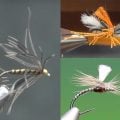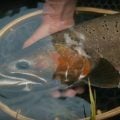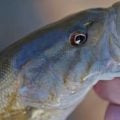How to Tie a Whistle Pig Jig
Producer: Tim Flagler
The Whistle Pig Jig is somewhat unique in that the tail, body and collar are all made up of the same material – woodchuck, also known as groundhog, or in Pennsylvania anyway, whistle pig.
I originally tied this on a standard hook with a regular bead head but really like the way it looks and fishes on a jig hook with a slotted tungsten bead. So here I’m using a size 12 Lightning Strike JF2 paired with a 1/8” copper-colored, slotted tungsten bead. Begin by picking up the bead and then the hook. Insert the point of the hook into the small hole of the bead and bring the bead around to the hook eye. Get the whole assembly firmly secured in the jaws of your tying vise. Make sure the squared-off end of the slot points down while the smaller curved end faces up.
We’re going to do some split thread dubbing on this one so a heavier thread like UTC 140 Denier in black will work well. Get your thread started immediately behind the bead and take wraps at the back edge of the bead until it stops moving. This little thread dam will both center and lock the bead in place. Then, begin taking thread wraps rearward, tapering down to the hook shank. Snip the tag end of thread off close.
Snip a small clump of woodchuck free from the skin, making sure to get both the guard hairs and the underfur. Gently pull out the underfur but don’t discard it. Instead, put it away in a safe place for later use. Corral the guard hairs and place them into a stacker, tips first then give them an ample stacking. Pull the aligned tips out of the stacker with your left hand then pass them to your right. Measure to form a tail that extends from the back edge of the bead to the back edge of the hook bend. Transfer that measurement rearward to the start of the bend. Take wraps of tying thread to bind the somewhat slippery guard hairs to the top of the hook shank all the way back to the start of the bend. Then take more wraps forward almost up to the bead. Lift the butt ends of the hair up and snip them off close. Continue taking thread wraps forward all the way up to the back edge of the bead, then back just a little ways.
Small-sized copper Ultra wire is used to segment the fly, a 6” length will make numerous flies. Place one end of the wire up into the slot of the bead and take thread wraps to secure it to the hook shank, all the way back to the base of the tail. Then wrap forward so your thread hangs at about the hook point.
Retrieve the small clump of the underfur you set aside earlier and use a portion of it to build up a thin dubbing noodle approximately 3” in length. With the noodle complete, take a few wraps so the dubbing begins right at the base of the tail. Once you have a single wrap of underfur around the hook shank, give your bobbin a good clockwise spin which will cord up both the thread and the dubbing into a tight little rope. Start taking wraps with the rope to build up a lightly tapered body on the fly. Continue taking wraps all the way up to the back edge of the bead.
Get hold of the copper wire and make open spiral wraps with it up the body of the fly, 5 or 6 segments usually looks pretty good. At the back edge of the bead, use your tying thread to firmly anchor the wire then helicopter to break it off close.
Now give your bobbin a counterclockwise spin to un-cord and flatten the thread. Once the thread’s flattened, use your bodkin to split it roughly in two. Pick up another small slip of the underfur and place it between the split strands. Having a few short guard hairs in the mix doesn’t hurt. With the fur in place, close the strands and give your bobbin a healthy clockwise spin to trap the material and turn it into a spiky-looking dubbing noodle. Start taking wraps with the noodle to build up a bushy-looking thread collar on the fly. If you feel like you have too much material, simply pull some out. When you’re satisfied with the look of the collar, give your bobbin a counterclockwise spin to make sure the thread isn’t corded up too much. Then complete a 4 or 5 turn whip finish and snip or cut your tying thread free.
An ample drop of head cement, here, Sally Hansen’s Hard as Nails, applied to the thread wraps behind the bead and allowed to sink in will ensure the wraps don’t come unraveled.
Once you get rolling, the Whistle Pig Jig is a nice, fast tie, mainly because there are so few materials. If it casts a shadow when it comes out of the tying vise, you might want to wait about 6 weeks before using it.
How to Tie a Wet Bibio Variant
How to Tie a Winter Wonder











